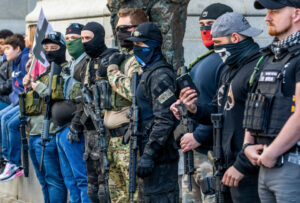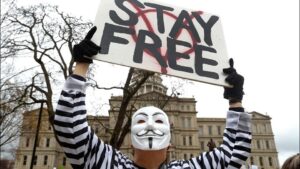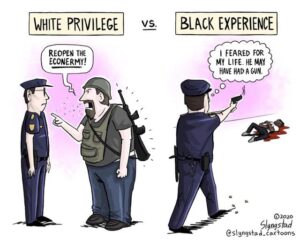Four years ago, on the eve of the 2016 U.S. presidential election, I made the dispiriting prediction that, regardless of who won (and, at the time, the notion that Donald Trump would win seemed inconceivable to most of us), America was witnessing the birth of a new civic (dis)order.
Four years later, in the shadow of another election, our world is both radically different — and dispiritingly similar. So it’s notable that the storyline of HBO’s dystopian, overwrought, and prescient 22nd-century series, Westworld, once again provides an edifying parallel to the real-life drama of 21st-century American public life.
If you haven’t watched it, Westworld is a show about a question at the heart of American identity: What does it mean to be free? — albeit in the context of watching what happens to our great-great grandchildren when their robot playthings become hip to the game and decide to exact some revenge.
In 2016, the show’s first season took place exclusively in an amusement park in which people paid obscene sums to act out obscene fantasies with humanoid robots whose memories would be wiped clean after each new day in an endless loop of unconscious servitude. But in 2020’s season three, Westworld (like our own) is in freefall. It turns out the owners of the park were secretly mining the data of their visitors in order to advance their own Orwellian notion of a more predictable social order. Meanwhile, a few robots have slipped the yoke, only to discover an outside world eerily similar to the one they’d just fled. As one character puts it, “They built the world to be a game — and then rigged it to make sure they always won.”
Which brings us to our own real-world dystopia — one in which Trumpian notions of “liberation” are merely a symptom of a much deeper malaise, and the Orwellian overlay is as relevant as ever, albeit in an even more chilling way than the worlds depicted in 1984 or on HBO.
That’s because, unlike the robots in Westworld or the proles in Oceania, we are not color-blind, but color-bound. And while this has always been true — the Peculiar Institution, after all, is America’s Original Sin — the Coronavirus pandemic has laid its enduring legacy even more nakedly at our feet.
As The Atlantic‘s George Packer puts it, the virus has exposed America’s underlying conditions in ways that reveal us to be, in effect, a failed state: “in prosperous cities, a class of globally connected desk workers dependent on a class of precarious and invisible service workers; in the countryside, decaying communities in revolt against the modern world; on social media, mutual hatred and endless vituperation among different camps; in the economy, even with full employment, a large and growing gap between triumphant capital and beleaguered labor; in Washington, an empty government led by a con man and his intellectually bankrupt party; and around the country, a mood of cynical exhaustion, with no vision of a shared identity or future.”
Here, too, the parallels between Real World and Westworld are instructive.
”How did you get here?” multiple characters are asked throughout the series. “Start at the beginning.”
If we take that question and apply it to ourselves, there’s only one American intersection where all roads converge — from the unmasking of our runaway wealth inequality to the bands of masked protesters demanding the country re-open so they can get a tattoo or eat a cheeseburger:
In this land — our land — freedom is whiteness (just ask Amy Cooper). And until that changes, we will remain trapped in our own endless loop of social, moral and spiritual decay.
As New York Times columnist Jamelle Bouie explains, citing the 1993 work of legal scholar Cheryl Harris, “Whiteness” has always been the defining characteristic of free human beings in America. To be white, therefore, is to have control over oneself and one’s labor, and to be subject to no one’s will but one’s own. And that tie between whiteness and freedom has only strengthened over the years — from Westward Expansion to Chinese Exclusion, or from Emmitt Till to Ahmaud Arbery and George Floyd.
“The great irony,” Bouie writes, “is that this conception of freedom, situated within racial hierarchy and meant to justify deprivation and inequality, has always been impoverished when compared with an expansive, inclusive vision of what it means to be free. And in the particular context of a deadly pandemic, the demand to be free of mutual obligation is, in essence, a demand to be free to die and threaten those around you with illness and death. Most Americans, including most white Americans, have rejected this freedom of the grave. But among the ones who haven’t are the people leading our government, which means that this ‘freedom’ remains a powerful — and dangerous — force to be reckoned with.”
Where to, then, from here?
In Westworld, the path forward leads to the most predictable, stereotypical end-goal of “revolution” — burn the motherfucker to the ground.
But Westworld’s characters also deliver lines that could be seen as beacons for our own desperately-required awakening. There are rare moments in life, one of them explains, “when randomness interacts with your life to create a truly free space where you can make a choice — a bubble of agency.”
This pandemic, and all it has laid bare, is our bubble. Yet as I wrote four years ago, the actions required of us include, and are not limited to, the next presidential election. And for those of us who are “white,” the reality is that the bulk of this work is ours to do — not because of some modern-day Kipling-esque fantasy about white exceptionalism, but because to unwind such deeply entrenched notions of privilege, the people who receive the benefits must be the main ones to demand that the system(s) be unwound.
To do so, however, as my friend Susan Glisson has wisely written, we must give ourselves the breathing room to question whiteness and its power over this nation. As Orwell himself once wrote, “the moral to be drawn from this dangerous nightmare situation is a simple one: Don’t let it happen. It depends on you.”



Barry Stern says:
Now is not the time to engage further victimization of demographic groups with high incidences of the Covid-19 disease. It is simply common sense to acknowledge that poverty, poor diets and unhealthy lifestyles are contributory factors. Let’s attack the pandemic in the places where it is most virulent and where underlying conditions are likely to be the most prevalent. Direct consequential action is what is needed. Save the blaming and victimization for another day!
Starting with what we know about the health impact of Covid-19 infections, here are a few causal factors that every government should address in their respective virus hotspots. Specifically, we should target resources to help prevent or mitigate early symptoms of the virus among the most susceptible:
• In their 60s or older.
• Are low income, poorly educated and/or live in neighborhoods with high poverty
• Have had little or poor primary medical care;
• Have pre-existing chronic conditions such as heart disease, high blood pressure, obesity, cancer, diabetes and Alzheimer’s
• Have compromised immunity systems due to many years of poor nutrition and lifestyle habits
• Live in densely populated areas with high degrees of chemical and electrical pollution
Communities should address all of these factors in areas with the highest incidence of Covid-19 cases and deaths through the following preventive measures:
1. Map out the zip codes and neighborhoods having high numbers and rates of hospitalizations and deaths from the Covid-19 virus.
2. Flood these high-risk areas with the following:
a) Medical clinics (temporary and permanent) staffed by primary care doctors and nurses who would conduct thorough physical exams and recommend/provide remedies to those who are sick. Publicize locations of these clinics and provide transportation round trips to residents who request them. Ensure that individuals with disabilities and the homeless are among the beneficiaries.
b) Provide these clinics with sufficient number of approved Covid-19 tests and personnel trained and equipped to administer the tests to all comers and report the findings to a central node. At least two kinds of tests would be provided: (1) whether the person currently has the virus and if not (2) whether s/he has antibodies indicating exposure to the virus and possible immunity to the disease. Medical staff would determine the best times for testing each individual following their development of an accurate chronical of the individual’s symptoms, relevant tests and treatments.
c) Supply fresh organic foods and supplements free of charge to area residents that are rich in vitamins C and D3, zinc and magnesium. Encourage heavy use of these foods and recommended diet changes through conveniently located, free classes in nutritional economics including hands-on practice in how to cook healthy yet inexpensive and tasty dishes. Mobilize and pay local restaurants to lead this effort, as well as residents who have been practicing these exemplary cooking and dietary habits for extended periods of time.
d) Take frequent measures of electrical magnetic radiation (EMR) in all medical treatment and public care facilities and where appropriate move them to locations with low amounts of EMR since high amounts stimulate virus replication and thus slow recovery times. As experience in Wuhan, northern Italy and Seattle has shown, it would be particularly important NOT to place elderly clients in nursing homes and hospitals with high EMR/electrical pollution, especially exposure to 5G .
e) Provide clinic waiting rooms with help desks, videos and take away printed materials in how to disinfect one’s domicile and practice social distancing.
Michelle M. says:
Barry Stearn, your perspective is clearly from a white privilege point of view. But mostly from your unwillingness to acknowledge or even explore the idea that maybe, just maybe an entire race of people can’t be wrong and America’s original sin plays a role in the ills of our society today. Bottom line, my response to your comment is one big eye roll! Whatever dude.